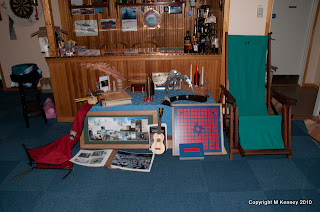It is tradition for all Antarctic bases from all nations to celebrate the winter solstice, or the passing of midwinters day. For bases like Halley at 76 degrees south, midwinters day will bring a welcome boost in morale, as for quite some time they will have been living in perpetual darkness. Passing the half way mark means that the days will start getting longer, and for the bases farther south the return of the sun. KEP at 54 south does not experience perpetual darkness. The days in winter are similar to those of the british winter in that we always have at least 8 hours of daylight a day. It is the case however that South Georgia, being situated East of the Drake Passage in the middle of the Southern Ocean, and devoid of the climatic tempering provided to the UK by the Gulf Stream, winters are on average considerably tougher than those of Britain.
Either way, it is a sterling excuse for a celebration. The lobby in Everson house (our accomodation block) is festooned with midwinter greetings from all the other Antarctic bases, and we all have a week of party games and celebrations. BAS arrange (without our knowledge) to have packages sent from our families back home (thanks mum for my lovely box!) and we also have the BBC Midwinter broadcast. The broadcast is a collection of greetings from our friends and family and is aired of the BBC world service and on the HF frequency band so we can tune in here. It was great to hear all the messages from back home.
We also have a midwinter feast, and present each other with the midwinter gifts we have been busily constructing over the last few months. The standard this year was incredibly high and all the gifts made showed a great deal of skill (existing or learned!) and a huge amount of effort. I would like to thank Sam the doc for my wonderful coffee table book. Sam is a talented photographer and has a very creative eye for graphic design. She has created a year book showcasing some of her wonderful photographs and documenting everything we have done since our arrival last year. Its not finished of course as some of this year's history is yet to occur. I drew Ruth, and I have made her a jewellery box out of white oak with purple heart and mwenge inlays and hardwood panelling. I lined the inside with old "fathom" charts of the Cumberland Bay area.
The other activities we had planned for the week have been postponed due to science duties getting in the way. Alistair and Matt have gone to sea on the Pharos to undertake some plankton trawls and other surveys, and therefore Midwinter Olympics (including human curling, sledge bowling etc), crazy golf, base pub crawl, wine and cheese tasting evening etc etc have been postponed until further notice.
I do feel the comforts of a modern antarctic base, belie the original reason for midwinters day celebrations. It is not our reality being sat huddled in a pyramid tent with the huskies keeping warm outside, sipping whisky and opening the celebratory can of bully beef. But the traditions are important to uphold, and well, its a whole lot of fun!
 |
| Our greeting to the other Antarctic Stations - Photo S Crimmin |
 |
| A midwinter cigar |
 |
| A selection of MWPs showing my jewellery box |
 |
| All handmade presents we made for each other. Note the Ukelele! |
 |
| Me and the boys set the table for dinner - didnt do a bad job I thought. |











